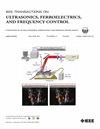Surface-Acoustic-Wave-Driven Acoustic Tweezing in a Silicon Microfluidic Chip
IF 3.7
2区 工程技术
Q1 ACOUSTICS
IEEE transactions on ultrasonics, ferroelectrics, and frequency control
Pub Date : 2025-06-20
DOI:10.1109/TUFFC.2025.3581642
引用次数: 0
Abstract
Surface-acoustic-wave (SAW)-driven acoustic tweezers (ATs) have been widely explored for high-resolution ultrasonic sample manipulation. Among these, hybrid ATs comprising a reusable SAW chip and a disposable glass or silicon microfluidic (MF) chip as a superstrate offer advantages such as reduced experimental costs and minimized cross-contamination between experiments. However, maximizing the acoustic pressure within the MF channel requires efficient acoustic coupling between the SAW and the MF structure. In this work, we investigate the frequency-dependent characteristics of acoustophoresis of 50-MHz hybrid ATs composed of an SAW chip and a silicon MF chip. We elucidate the role of the bulk acoustic wave (BAW) resonances in the silicon substrate in facilitating the formation of acoustic standing waves (SWs) within the MF channel. The experimental results demonstrate the generation of acoustic pressures up to硅微流控芯片中表面声波驱动的声镊。
表面声波(SAW)驱动声镊被广泛用于高分辨率超声样品处理。其中,混合声镊子由可重复使用的SAW芯片和一次性玻璃或硅微流控芯片组成,具有降低实验成本和最小化实验间交叉污染等优点。然而,最大限度地提高微流控通道内的声压,需要声SAW和微流控结构之间有效的声学耦合。在这项工作中,我们研究了由SAW芯片和硅微流控芯片组成的50 MHz混合声镊的声阻抗频率依赖特性。我们阐明了硅衬底中体声波共振在促进微流控通道内声驻波形成中的作用。实验结果表明,通道内产生的声压可达2.1±0.5 MPa。该装置成功地用于检测HEK293T细胞的瞬态粘弹性变形和捕获运动细胞四膜膜。这些发现突出了所提出的混合声学镊子作为软物质和生物样品的外部机械测试平台的潜力。
本文章由计算机程序翻译,如有差异,请以英文原文为准。
求助全文
约1分钟内获得全文
求助全文
来源期刊
CiteScore
7.70
自引率
16.70%
发文量
583
审稿时长
4.5 months
期刊介绍:
IEEE Transactions on Ultrasonics, Ferroelectrics and Frequency Control includes the theory, technology, materials, and applications relating to: (1) the generation, transmission, and detection of ultrasonic waves and related phenomena; (2) medical ultrasound, including hyperthermia, bioeffects, tissue characterization and imaging; (3) ferroelectric, piezoelectric, and piezomagnetic materials, including crystals, polycrystalline solids, films, polymers, and composites; (4) frequency control, timing and time distribution, including crystal oscillators and other means of classical frequency control, and atomic, molecular and laser frequency control standards. Areas of interest range from fundamental studies to the design and/or applications of devices and systems.

 求助内容:
求助内容: 应助结果提醒方式:
应助结果提醒方式:


